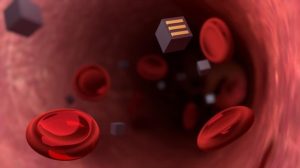Turning Our Bodies Into Big Brother’s Toys
April 17, 2018
Computer chips and silicon micromachines
are ready for your body. It’s time to decide how you’ll take them: implantable,
ingestible, or intimate contact. Every flavor now exists. Some have
FDA approval and some are seeking it. Others are moving quickly out of the
research lab stage. With the round one
Qualcomm Tricorder X-Prize entries due in one year, we’re soon to
see a heavy dose of sensors tied to the mobile wireless health revolution. With
these sensors comes a heavy dose of information about your health, data about
what medication you are taking and when you took it. The sensors are
available to protect your health, but choosing how to use them and how to
protect the privacy of your data will be a matter of personal responsibility.

Implantable
sensors exist for a number of applications, having been used in animals for pet
identification for many years. Other examples under development or seeking FDA
approval are glucose detection for control of diabetes,
blood pressure monitoring in people with recent cardiac arrest or risk
of heart disease, and
blood health. The most recently announced is implanted into
animal
brains with the long-term goal of enabling humans with paralysis to
control machines with their minds. These implantable sensors have this
in common: they self-contain what is needed to transmit information from
inside your body without batteries and without wires. These are
already shown to work; several are now seeking FDA approval. From the
perspective of a patient, this is a Tricorder device, albeit one centered on an
implantable micromachine sensor. If you or your doctor feel your health is at
risk, I suspect you’d accept these inside your body. If your health feels not
at risk however, this could be too invasive for your liking, and we’ll offer you
something one level easier to accept.

Ingestible
sensor chips are an idea a little easier for most people to swallow. Here are
three examples. Camera pills, which pass through your
digestive tract taking pictures and transmitting them out are
available from
Given Imaging. Available to your doctor, that is. You may have seen the
commercials. But two other swallowable sensors are now on the scene. You can
find the
Internet movies of Lance Armstrong downing the CorTemp thermometer pill from
HQInc. This pill travels through your digestive tract wirelessly
transmitting your core body temperature. Useful for athletes today,
and for those with occupational exposure to high temperatures. Again, this
mimics a singly-capable Tricorder device where hand-held electronics receive
wireless signals about the temperature inside your body. A third ingestible, a
wireless sensor pill from
Proteus Digital Health does something simple, but vitally important: it
reports that you’ve swallowed it. This first offering from Proteus is a
placebo, with silicon computer chip attached. This pill, coupled to a wearable
patch, which is coupled to a smart phone has been discussed in an
article here at Forbes/Singularity previously. When the pill hits
your stomach, it transmits to your phone that you took the pill. Your
phone then does whatever you would like with the data; informs your
doctor, or informs a trustworthy caregiver. If Proteus is right, and
these sensors become commonplace, exponential growth in digital medicine for
compliance monitoring will require as much silicon wafer manufacturing as all
computer chips use today. And your phone will be filled with information about
when you took your medication.

Related Links:
*
First Digital Pill Approved to Worries About
Biomedical ‘Big Brother’
*
Ingestible Sensors Electronically Monitor Your Guts
*
Ingestible smart sensors: body/immune system data from the inside out
*
Magnetic microbot uses tumble locomotion for mobility, solving usage issues
*
Nano ‘drones’ could help prevent certain type of heart attack – study
*
Google nanobots: Early warning system for cancer, heart disease
* Robotic
implants spur tissue regeneration inside the body
*
Implantable wireless devices trigger, and may block, pain signals
* Implant
for opioid addicts gets thumbs up from FDA advisers
*
‘Origami Robot’ May Cure Stomach Aches Of The Future
*
Light illuminates the way for bio-bots